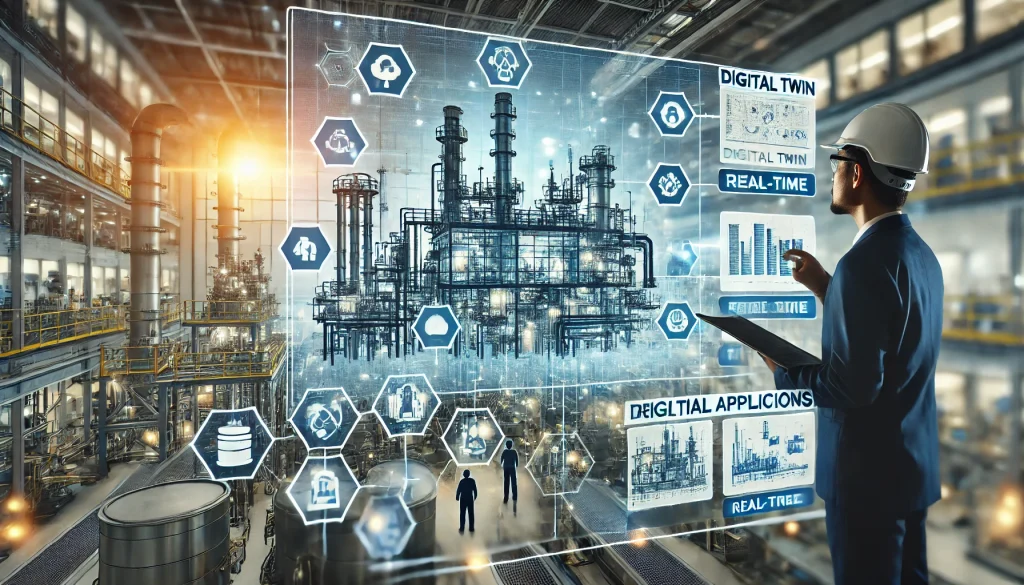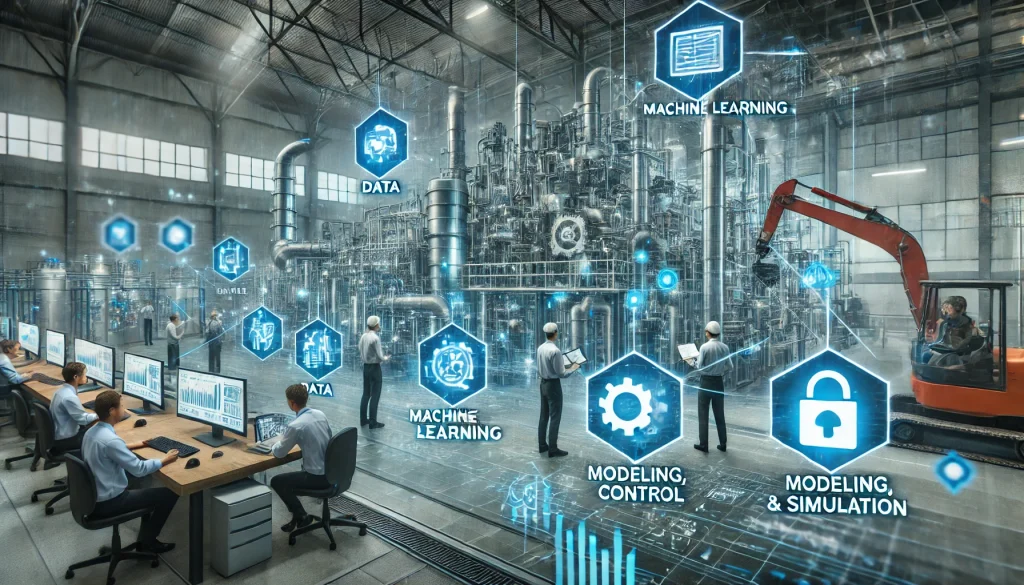Artificial Intelligence (AI) has emerged as a transformative force in Process Systems Engineering (PSE), enabling more efficient, flexible, and intelligent solutions for the design, optimization, and control of complex systems. In PSE, AI is primarily applied through machine learning (ML), reinforcement learning (RL), and Physics-Informed Machine Learning (PIML). These technologies allow engineers to enhance process efficiency, reduce operational risks, and enable predictive control across various industries, from petrochemicals to pharmaceuticals.
By leveraging data-driven models, AI empowers process engineers to optimize large-scale operations in real-time, identifying patterns and making decisions that improve system performance. The integration of AI in PSE not only accelerates the automation of processes but also facilitates the development of smart systems that can adapt to changing conditions and uncertainties in industrial environments.
The Role of Machine Learning (ML) in Process Optimization
Machine learning (ML) is perhaps the most widely recognized and applied AI technique in PSE. ML models are capable of learning from historical process data, allowing engineers to identify optimal operational parameters, predict failures, and improve product quality. ML-driven process optimization involves analyzing large datasets to uncover trends and correlations that would be difficult to identify manually.
From my own experience in process optimization, the use of ML algorithms has been instrumental in developing predictive maintenance strategies. These models can anticipate equipment failures before they occur, reducing downtime and improving overall system efficiency. Additionally, ML helps in fine-tuning processes by predicting how changes in inputs or operating conditions will affect outputs, leading to more consistent and optimized production.
Physics-Informed Machine Learning (PIML): Integrating Physical Laws into AI Models
One of the key challenges in using traditional machine learning models in PSE is their reliance solely on data, without considering the underlying physical laws governing the system. This is where Physics-Informed Machine Learning (PIML) comes into play. PIML integrates domain knowledge and physical principles into the learning process, ensuring that models not only learn from data but also respect known physical constraints.
In the context of Process Systems Engineering, PIML allows for the creation of more accurate and reliable models. For example, by embedding thermodynamic laws or fluid dynamics into a machine learning model, engineers can improve the model’s predictive accuracy while ensuring that the predictions are physically feasible. This approach enhances the robustness of AI models, especially when applied to complex systems with multiple interdependent variables, such as chemical reactors or energy systems.
Reinforcement Learning (RL) for Dynamic Control and Decision-Making
Reinforcement learning (RL) is a type of AI where the model learns to make decisions through trial and error, receiving rewards for actions that lead to desired outcomes. In PSE, RL has proven particularly useful for dynamic control of processes that operate under uncertain conditions. RL models continuously learn from the environment, adjusting their strategies to maximize long-term performance.
A prominent example of RL’s application is in real-time process control. In situations where traditional control systems struggle to adapt to frequent changes in operating conditions, RL-based controllers excel by learning optimal control policies that adapt to the process as it evolves. In my work with dynamic scheduling, RL has been used to manage the real-time allocation of resources in complex manufacturing environments, helping to improve throughput and reduce energy consumption.
Transfer Learning (TL) in Process Systems: Accelerating Model Training
Transfer learning (TL) is an advanced AI technique that allows models trained on one problem to be adapted for use on a related problem. In the context of PSE, TL can significantly reduce the time and computational resources required to train models, especially when dealing with systems where data collection is costly or time-consuming.
For instance, in large-scale industrial processes where similar equipment is used across multiple plants, a model trained to optimize operations in one facility can be transferred to another with minimal retraining. This transferability is especially useful in cases where data scarcity is an issue, allowing for faster deployment of AI solutions across multiple sites.
In my experience, transfer learning has been particularly effective in optimizing batch processes in different production facilities. By transferring knowledge from one plant to another, we were able to reduce the setup time for new models and achieve performance improvements more quickly than starting from scratch.
Applications of AI in Predictive Control and Diagnostics
Predictive control and diagnostics are areas where AI, particularly ML and RL, have revolutionized traditional methods. Predictive control allows for the real-time adjustment of process parameters based on forecasted outcomes, while diagnostics involves detecting faults and predicting failures before they occur.
In chemical and biochemical industries, predictive models are used to control reactor conditions, ensuring that chemical reactions proceed optimally while minimizing the risk of accidents or inefficiencies. AI models can process massive amounts of sensor data in real-time, adjusting variables such as temperature or pressure to maintain steady-state conditions. Similarly, diagnostic systems powered by AI can identify early warning signs of equipment failure, allowing operators to take preventive measures before costly downtime occurs.
One of the most valuable applications of AI in my projects has been predictive maintenance, where real-time data from sensors is fed into ML models to forecast equipment health. This proactive approach not only reduces operational costs but also improves the reliability and safety of the processes.
Challenges and Opportunities of AI in PSE
Despite the numerous advantages of AI in Process Systems Engineering, there are several challenges that need to be addressed for broader adoption. One of the primary challenges is the integration of AI models with existing process control systems. Many industrial environments still rely on legacy systems that are not easily compatible with modern AI technologies.
Another significant challenge is the interpretability of AI models. In industries like pharmaceuticals or petrochemicals, regulatory requirements demand transparency in how decisions are made. As AI models, especially deep learning algorithms, can often function as “black boxes,” there is a need for more explainable AI (XAI) solutions that provide insights into how decisions are reached.
However, these challenges also present opportunities. As industries increasingly adopt smart manufacturing and Industry 4.0 technologies, AI will play a pivotal role in bridging the gap between traditional processes and the highly automated, data-driven systems of the future. The development of more interpretable and robust AI models, such as those informed by PIML, will be crucial in gaining wider acceptance in highly regulated industries.
Future Trends: AI-Driven Process Automation and Optimization
The future of AI in PSE lies in process automation and the creation of self-optimizing systems. AI-driven automation will enable processes to adjust automatically in response to real-time data, reducing the need for human intervention and allowing for more efficient resource management. AI-enhanced systems will be able to autonomously monitor performance, predict potential issues, and adjust operations to optimize output.
Moreover, advancements in deep reinforcement learning and transfer learning will further accelerate the deployment of AI in industries that require highly dynamic and adaptive systems. These technologies will empower engineers to design processes that not only operate at peak efficiency but also learn from their environments to continuously improve.
As AI continues to evolve, the integration of cognitive systems capable of learning and adapting in real-time will redefine the role of process engineers, shifting the focus from manual operation to the orchestration of intelligent systems that optimize performance across multiple dimensions—cost, energy efficiency, and safety.
Advanced Process Control (APC)
Advanced Process Control (APC) refers to a collection of techniques and technologies used to optimize…
Numerical and Computational Methods
Numerical and computational methods are essential tools in Process Systems Engineering (PSE), enabling engineers to…
Artificial Intelligence in Process Systems Engineering (PSE)
Artificial Intelligence (AI) has emerged as a transformative force in Process Systems Engineering (PSE), enabling…
Real-Time Applications and Digital Twins
Real-time applications (RTAs) are systems that process data instantaneously, delivering results or actions within predefined…
Process Systems Engineering (PSE)
Process Systems Engineering (PSE) is a multidisciplinary field that focuses on the design, modeling, analysis,…





